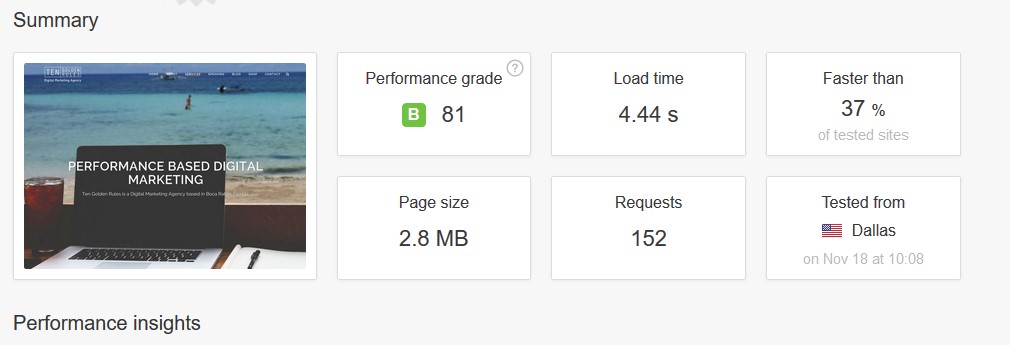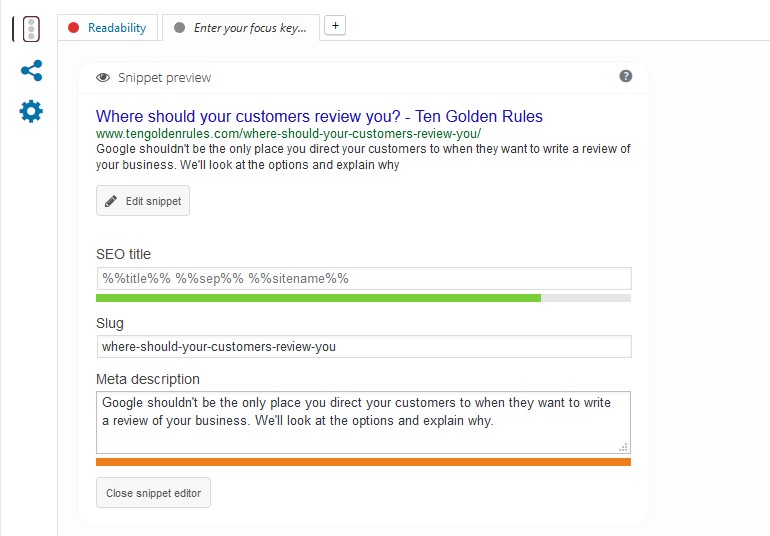5 tips to monitor your websites seo health

On November 12-13 at Ten Golden Rules’ ADMLive! conference, in one of the sessions, we presented the ABC’s of Search Engine Optimization. Many people approached me afterwards, and asked what simple steps they could take to check the organic health of their website.
Below we compiled a list five items that you can monitor on your own to check the health of your site, and see incremental increases in your organic traffic.
Some of the items may need an experienced webmaster to implement or fix, but at least you know where the issues are and why they affecting the performance of the site. Imagine taking your car in for service and instead of saying you hear a clunking noise coming from the front of the car, you say, “The front shock absorber has a bent strut which is causing the axle bracket to rub against the wheel housing. This is causing damage to Part X, and diminishing the performance of the vehicle.” After your mechanic picks up his jaw from the ground, he gets right to fixing the exact problem.
- Site Speed
You go to a conference or you speak to your geeky internet friends, and they all say site speed is important. They’re right, but what does that really mean?
I have a nine-year-old and he loves Legos. So, think of building that latest Lego Ninjago battle station the same as how your web browser builds/displays your website.
Your website is made of many different pieces of code and files that all need to be assembled (in a specific order) to create your webpage. Site speed refers to the amount of time your web browser takes to put all those pieces together. When I build the battle station for my son, it will take less time if all the pieces are laid out in order. It also helps if some of the more complicated items come prepackaged and already put together. That reduces the time I spend trying to find that pesky round piece that rolled under the couch.
One tool we use at Ten Golden Rules is tools.pingdom.com. It’s pretty simple to use, just enter your site URL and after a few seconds it will return the following result.
 There are three items in this result to notice:
There are three items in this result to notice:
Load Time – this is the time it took to collect all the elements to build the webpage. The larger and more complicated the page, the longer it will take to build. Ideally, it should be between two and three seconds.
Page Size – This is the size of all the files, javascript, text and images that are needed to build the page. Images are usually the culprit here regarding a large number. Make sure they are as small as possible in file size that retain the highest quality. Under 3MB is fine.
Requests – In the Lego example above, this would be the number of pieces that need to be put together. As you can imagine, if lots of the pieces came already assembled it would reduce the time. Same here, if you can combine some of the javascript files or css files, it will reduce the number of times a request needs to be made for a piece of information.
This tool will give you a list of recommendations that you can take to your webmaster to improve the results.
- Domain Registration Length
This is a simple one. If you show some faith in your business, so will Google. Going to GoDaddy each year and spending your $9.99 to register your domain for another year tells Google you’re not really in this for the long haul. Show some faith in yourself and register the domain for the max allowable time, 5 years, 10 years. It’s not that much money, and Google now has indication that you’re going long with your business.
Another reason why this is important: There are people constantly looking for domains that are not renewed. If you lose the renewal notice – it gets sent to an employee who is no longer around, the cc on file with the registrar is no longer valid – you may lose your domain, and in many cases, that could be your whole business.
- Images
As mentioned before, the large image you have on your home page, while looking amazing, may be slowing down your site. When adding images to your site, ensure the file size of image is as small as possible while still maintaining the quality you are looking for. If you are using Word Press, don’t forget to add some alt text for every image you upload.
 The alt text is a great way to add additional text and keywords for the Search Engines to crawl.
The alt text is a great way to add additional text and keywords for the Search Engines to crawl.
- Meta Titles and Descriptions
If there is one thing you do when you create a new page for your website, it’s make sure you add a Title and Meta Description. It takes only a couple of extra minutes, and the benefits will help your posts get indexed and ranked quicker.
Here are some quick guidelines:
Meta Title – Should be unique, include primary keyword for the page and be under 65 characters.
Meta Description – Should be unique, descriptive and be under 160 characters.
If you have a Word Press site, we recommend you add a plug in that will allow you to add the Title and the Description as you add new content. If you chose the plugin ‘Yoast SEO,’ note that it requires you to manually add the description under the guise that it should be unique and descriptive.

- Google Free Tools
Out of the goodness of their heart, Google has gone out of their way to produce tools that will allow you to monitor your website and give you recommendations on what kind of improvements you can make. Given they have made them available, use them.
Google Analytics – While there are several options for analytics tracking for your website, Google Analytics provides all the tools necessary for any small to medium size business to be able to monitor and optimize their site. (My next blog post will look into some of the basics for a small business owner to look at after they have set up their Google Analytics account.)
Google Search Console – I’m continuously amazed that so many people do not take advantage of Search Console (formerly called Webmaster Tools) for their website. After placing a small snippet of code on your home page (or you can verify your site based on your Google Analytics Account), you unlock all sorts of data regarding the health of your site, along with providing Google an avenue to contact you when they find a major problem with the site.
1) Submit your XML sitemap
2) Identify pages that are returning a ‘Page not Found’ error
3) Identify keywords that are gaining impressions, and clicks to your site (create free keyword research location)
4) Check the sites that are linking to your site. Look for undesirable links and start the process to remove
Page Developer Tools Site Speed – This is another site speed test that will analyze and make recommendations on how to improve the speed of the site for both desktop and Mobile.
[/vc_column_text][/vc_column][/vc_row]

